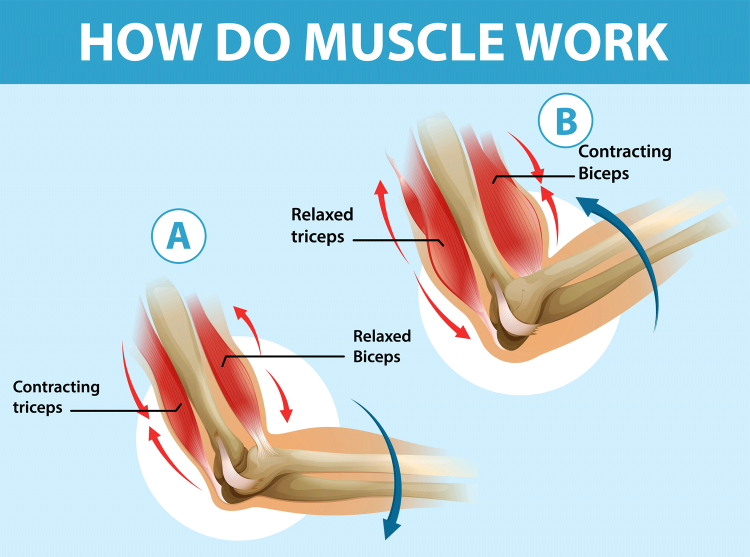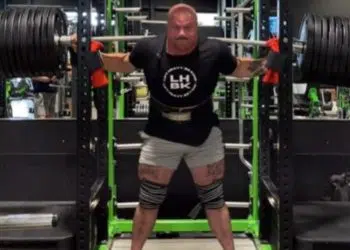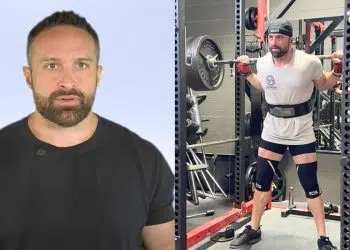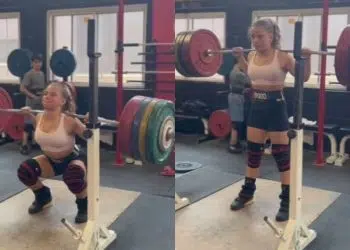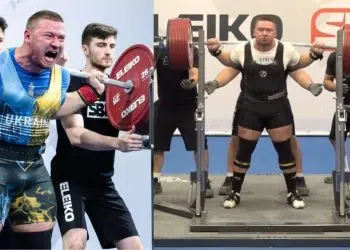Are you ready to take your leg gains to the next level? Then it’s time to try eccentric squats!
Squats are the crowned king of exercises. This isn’t just my opinion; squats have long been the preferred exercise of bodybuilders, strongmen, and athletes. It doesn’t matter if you want to get strong, build muscle, or improve your athletic performance. Squats will help!
However, that doesn’t mean you have to confine yourself to plain-vanilla barbell back squats. While that is a great exercise, there is more than one way to skin the proverbial cat.
Over the course of my 30+ years working in the fitness industry, I’ve experimented with lots of different squat styles and techniques. I’ve also used those methods with my clients. As a consequence, I’ve learned a lot about what works and what doesn’t.
One training tool I come back to time and time again is eccentric and accentuated eccentric training. These methods overload the negative portion of your rep, producing awesome, science-backed gains in strength, power, and muscle size (1). Eccentric training is especially effective for squats.
In this article, I reveal the effects and benefits of eccentric squat training and share some of my favorite eccentric squat exercises.
Level Up Your Fitness: Join our 💪 strong community in Fitness Volt Newsletter. Get daily inspiration, expert-backed workouts, nutrition tips, the latest in strength sports, and the support you need to reach your goals. Subscribe for free!
What is Eccentric Training?
Your muscles generate force in three ways. These are:
- Concentric – while shortening, e.g., lifting a barbell during biceps curls
- Isometric – without changing length, e.g., during planks
- Eccentric – while lengthening, e.g., descending into a deep squat
While all types of muscle contraction can increase size, strength, and power, emphasizing the eccentric phase may produce superior results. Eccentric training does precisely that.
Eccentrics for Hypertrophy (Muscle Growth)
Many exercisers are great at lifting weights, but not so good at lowering them. This results in leaving gains on the table, as they end up missing out on what is arguably the most productive part of each rep.
Isometric contractions are critical for maximizing muscle hypertrophy or growth. While the mechanisms are somewhat unclear, a meta-analysis published on PubMed suggests that you’ll build more muscle more quickly if you emphasize the eccentric part of your lifts (2).
Eccentric squats and the other variations below will help maximize the size of your quadriceps, hamstrings, and gluteus maximus.
Eccentrics for Strength
You are about 20% stronger eccentrically than you are concentrically. In other words, you can lower more weight than you can lift. Eccentric squats and their variations expose your muscles to more weight than they can typically handle, leading to greater strength increases.
In studies, eccentric-only and accentuated eccentric training is shown to be more effective for building strength than concentric training (3). However, exposing your muscles to greater loads than normal can lead to severe post-exercise muscle soreness, so don’t do too much too soon.
Eccentrics for Power
Power refers to your ability to generate large amounts of force very rapidly. It’s a component of most sports, and critical in activities like running, jumping, throwing, and kicking. Eccentric contractions result in the greatest amount of force production for the least amount of muscular effort and energy. Therefore, it’s a very effective training method for enhancing power production.
Eccentric training triggers two primary mechanisms – the stretch-shortening cycle, or SSC, and the stretch-shortening reflex, or SSR (4). These describe how, when a muscle is loaded and stretched, it responds with a powerful contraction. Imagine stretching a rubber band or compressing a spring and letting it go.
Eccentric exercises overload these mechanisms and train your muscles and nervous system to generate more force as required.
You now know how emphasizing eccentric contractions can help you reach your training goals. Therefore, it’s time to look at the best eccentric squat variations, all tried and tested by me and my clients.
Eccentric Squat Variations to Try
There are numerous ways you can maximize the eccentric phase during squats, and I’ve tried them all! Here are the ones that my clients and I have had the most success with.
Please note that all eccentric squat variations develop muscle size, strength, and power. However, each variation works differently and, consequently, will improve some muscular fitness components more than others. As such, I’ve indicated which one is best for each purpose.
1. Slow Eccentric Squats
Best for: Strength and hypertrophy
This is the best place to start your eccentric squat journey. You can apply this method to any kind of squat, including bodyweight or air squats, dumbbell squats, and front and back barbell squats. You can also exaggerate the eccentric portion of any lower body exercise to make it more effective, including leg presses and leg extensions.
Steps:
- Get into the correct starting position for your chosen squat variation. Brace your core, and pull your shoulders back and down.
- Bend your legs and descend smoothly and under control until your thighs are at least parallel to the floor. Take 3-5 seconds to complete your descent.
- Drive your feet into the floor and stand up explosively.
- Reset your core, and repeat.
Tips:
- Make the transition between eccentric and concentric phases as quick as possible.
- Keep your weight on your heels and push your butt back to maximize hip engagement.
- Experiment with the width of your stance to determine what feels most comfortable and effective.
2. Hatfield Squat
Best for: Strength and hypertrophy
The Hatfield squat is named after powerlifter Fred “Dr. Squat” Hatfield, who was the first man to squat 1000 pounds. This exercise requires a safety squat bar, which is a sort of yoke apparatus found in many gyms. This exercise overloads the eccentric and leaves your arms free so you can use them to self-assist during the concentric phase.
Steps:
- In a power rack, rest the safety squat bar across your upper back. Stand with your feet shoulder-width apart, toes turned slightly outward. Brace your core and grip the power rack uprights.
- Bend your knees and descend until your thighs are at least parallel to the floor.
- Using your arms for assistance, drive your feet into the floor and stand up explosively.
- Reset your core and repeat.
Tips:
- Load the bar with more weight than you typically use for squats, e.g., an extra 10 percent.
- Avoid using your arms on the descent, other than for balance.
- Consider wearing a weightlifting belt for increased lumbar stability and stronger bracing.
Related: Does Wearing a Lifting Belt Enhance Strength?
3. Weight-Releaser Eccentric Squat
Best for: Strength and power
This exercise lets you lower more weight than you lift. However, on the downside, you’ll only be able to do one eccentrically-loaded lift. Consequently, this is a “quality, not quantity” exercise, making it ideal for building low-rep strength and power. Gyms often have weight releasers, or you can buy them for personal use.
Steps:
- Load and hang the weight catchers from your barbell. Rack and hold the barbell on your upper back. Brace your core and lift your chest.
- Stand with your feet roughly shoulder-width apart, toes turned slightly outward.
- Bend your legs and squat down until your thighs are about parallel to the floor and the weight catchers disengage. Take 3-5 seconds to complete your descent.
- Drive your feet into the floor and stand up explosively.
- Rerack the bar, reattach the weight catchers, and get ready for another rep.
Tips:
- Adjust your weight catchers to ensure they release at the appropriate squat depth.
- Load the weight catchers with approximately 10% of your squat weight. Increase the load as you become more familiar with the exercise.
- Increase the hypertrophic effects of this exercise by doing more reps after the weight releases.
4. Single-Leg Eccentric Box Squat
Best for: Strength and hypertrophy
Level Up Your Fitness: Join our 💪 strong community in Fitness Volt Newsletter. Get daily inspiration, expert-backed workouts, nutrition tips, the latest in strength sports, and the support you need to reach your goals. Subscribe for free!
Some eccentric squat methods are very advanced or require specialized equipment. This exercise is much simpler and more accessible. It provides a straightforward way to overload the eccentric phase of your squat, and it’s so basic that all you need is a box or bench to do it. As such, this movement is perfect for home workouts.
Steps:
- Stand with your back to a knee-high bench or box. Brace your core, and pull your shoulders down and back.
- Shift your weight over onto one foot. Extend your other leg out in front of you.
- Bend your supporting leg and descend until your butt is resting on the box. Take 3-5 seconds to complete your descent.
- Use both legs to stand up, and then repeat.
- Do the same number of reps on both legs.
Tips:
- Overload the eccentric even more by holding a kettlebell or dumbbell under your chin.
- You can also do this exercise using an alternating leg action.
- This is an excellent preparatory exercise for pistol squats.
5. Self-Assisted Shrimp Squat
Best for: Strength and hypertrophy
While many exercisers want to learn how to do pistol squats, in my experience, the shrimp squat is just as effective but easier to master. It requires less balance and mobility, but the overload on your muscles is similar. This self-assisted variation provides a great way to overload the eccentric portion of this awesome leg exercise.
Steps:
- Stand with your feet together and hold a waist-high support, e.g., a railing, squat rack, or Smith machine barbell. Brace your core and set your shoulders back and down
- Shift your weight over onto one leg and bend your knee, pulling your foot into your butt.
- Keeping your non-working leg bent, squat down until your knee lightly touches the floor. Take 3-5 seconds to complete your descent.
- Using your arms for assistance, drive your foot into the floor and repeat.
- Continue for the desired number of reps, swap sides, and repeat.
Tips:
- Place a foam pad or folded gym mat under your knee for comfort.
- Use your arms as little as possible during the eccentric phase. Let your muscles do the work.
- Work hard to ensure your knees do not cave in during this exercise, which could result in injury.
6. Dumbbell Squat Jump
Best for: Power
While it might seem odd to include squat jumps in a list of eccentric leg exercises, they’re actually a good fit. That’s because, as you land, you’ll need to generate a powerful eccentric contraction to control your descent into your next rep. If you don’t, your legs will just collapse like wet noodles! Consequently, dumbbell squat jumps are an excellent eccentric-emphasis leg exercise.
Steps:
- Stand with your feet shoulder-width apart, toes turned slightly outward. Hold a dumbbell in each hand. Pull your shoulders back and down, and brace your core.
- Descend into a quarter to half-depth squat.
- Extend your legs explosively and leap up as high as possible.
- Land on slightly bent knees and descend into another rep.
Tips:
- This is a high-impact exercise and may not be suitable for knee pain sufferers.
- Wear supportive, cushioned shoes for this exercise.
- You can also do squat jumps using a barbell or weight vest for resistance or without weights if preferred.
7. Depth Jump
Best for: Power
Depth jumps, like squat jumps, use gravity and velocity to overload your muscles eccentrically. However, instead of weights, you start your jump by stepping off a raised platform, so your muscles have to work much harder to control your descent. Depth jumps are a common sports-training exercise, and an effective way to develop explosive power.
Steps:
- Stand on a raised platform that’s about 12 to 18 inches high.
- Step off the platform and land with your knees bent to absorb the shock of landing.
- Descend into a quarter to half-depth squat and then leap as high as possible.
- Return to your platform and repeat.
Tips:
- Place several platforms in a row to do a series of depth jumps.
- Only attempt this exercise after several months of squat jump training.
- Make sure your transition between landing and jumping is as rapid as possible. Imagine the floor is red hot.
Eccentric Squats – FAQs
Do you have a question about any of these exercises or how to train your legs for maximum gains in minimal time? Don’t worry – I’ve got you covered. Also, please feel free to post additional questions in the comments section below, and I’ll get back to you ASAP.
1. How should I program these exercises?
Your use of these exercises should match your training goals. Here are some guidelines to follow:
For power, use heavy weights, low reps, and perform concentric or lifting phases as explosively as possible. Imagine you’re jumping, even if you’re only doing squats. Step your set when you feel your rep speed starting to decrease. 1-6 reps and 2-3 minutes rest between sets works well.
For strength, use heavy weights and low reps, taking long rests between sets. However, while you should still try and lift the weight as fast as possible, the magnitude of the load will probably mean it still moves quite slowly. It’s also okay to grind out your last few reps.
For hypertrophy, use moderate weights and medium reps, typically 8-20 per set. Control the eccentric and power through the concentric, but don’t worry if you start to slow down as your muscles begin to tire. Rest for 1-2 minutes between sets, and expect to feel a burning sensation in the target muscles.
Use the exercises that best match your training objectives. I’ve highlighted the main purpose of each movement in the descriptions.
2. My legs are very sore after doing these exercises. Is that normal?
While eccentric training is an effective way to build muscle, strength, and power, it’s also linked to increased delayed onset muscle soreness or DOMS for short. While the exact causes of DOMS are unknown, we do know that eccentric contractions tend to make it worse.
You can minimize DOMS by warming up thoroughly before your workout and cooling down properly afterward. You should also avoid doing too much eccentric training too soon (5). In addition, DOMS tends to lessen over time because of the repeated bout effect (5). This term describes how your body adapts and gets used to the demands of your workouts.
3. Can I use eccentric training with other exercises and body parts?
Eccentric training is a very valuable training tool you can use with other exercises and muscle groups. It’s an excellent way to break through progress plateaus, increase your ability to perform specific exercises, and make your programs more varied.
Examples of eccentric training include:
- Controlled eccentric bench presses
- Negative only pull-ups
- Plyo and depth-jump push-ups
- Forced (partner-assisted) reps
- Self-assisted preacher curls
You can read more about eccentric training in this in-depth guide.
4. How often should I train my legs?
While you can make good gains training your legs once a week, I usually recommend two workouts. This provides a better work/rest balance and helps minimize DOMS by accelerating the repeated bout effect.
With this in mind, I like to separate quadriceps and hamstrings into separate workouts. This allows each muscle group to be trained harder and with more volume.
Read more about this approach in my guide to twice-a-week leg training.
5. Are eccentric squats safe for all exercisers?
This is a tricky question to answer, because it depends on which variation we’re discussing. For example, slow eccentric squats are very safe, as they really only involve descending with control. In contrast, weight-release squats are riskier because you’ll be using heavier loads than normal.
So, consider the demands and effects of each exercise, and compare that to your experience, abilities, and injury history. If in doubt, use light loads to determine whether a movement is suitable. Alternatively, stick with the less demanding exercises.
Closing Thoughts
Squats are one of the most productive exercises you can do. However, that doesn’t mean you have to use the same variations over and over again. In fact, not varying your workout enough is a good way to get stuck in a training rut.
Eccentric squats and the other variations outlined in this article will take your leg workouts to a new level. You can use these movements to build strength, power, and muscle mass. It all depends on how you program them.
However, make sure you introduce these exercises gradually. Many of them are more challenging than they sound, and overdoing it will result in potentially crippling DOMs. So, don’t say I didn’t warn you!
References:
- Hody S, Croisier JL, Bury T, Rogister B, Leprince P. Eccentric Muscle Contractions: Risks and Benefits. Front Physiol. 2019 May 3;10:536. doi: 10.3389/fphys.2019.00536. PMID: 31130877; PMCID: PMC6510035.
- Krzysztofik M, Wilk M, Wojdała G, Gołaś A. Maximizing Muscle Hypertrophy: A Systematic Review of Advanced Resistance Training Techniques and Methods. Int J Environ Res Public Health. 2019 Dec 4;16(24):4897. doi: 10.3390/ijerph16244897. PMID: 31817252; PMCID: PMC6950543.
- Harris-Love MO, Gollie JM, Keogh JWL. Eccentric Exercise: Adaptations and Applications for Health and Performance. J Funct Morphol Kinesiol. 2021 Nov 24;6(4):96. doi: 10.3390/jfmk6040096. PMID: 34842737; PMCID: PMC8628948.
- Davies G, Riemann BL, Manske R. CURRENT CONCEPTS OF PLYOMETRIC EXERCISE. Int J Sports Phys Ther. 2015 Nov;10(6):760-86. PMID: 26618058; PMCID: PMC4637913.
- Pincheira PA, Hoffman BW, Cresswell AG, Carroll TJ, Brown NAT, Lichtwark GA. The repeated bout effect can occur without mechanical and neuromuscular changes after a bout of eccentric exercise. Scand J Med Sci Sports. 2018 Oct;28(10):2123-2134. doi: 10.1111/sms.13222. Epub 2018 Jun 7. PMID: 29790207.

